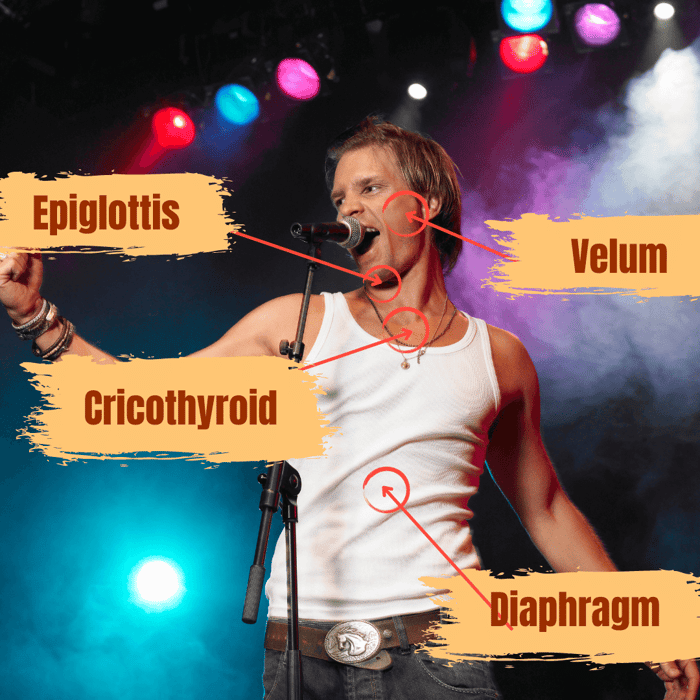So you want to sing higher notes and build vocal range.
Easier, better, with more power and a better tone.
I hear you, this was the reason I first started taking vocal lessons some 20+ years ago - because I didn't have any high range.
In fact, even my low range sucked - but at least I could kind of sing the low stuff.
High notes eluded me for many years, even after thousands of dollars of singing lessons... until I learned these 4 proven ways to build vocal range.
The first is to find your CT muscle.
The Cricothyroid muscle, or "CT" muscle, is located underneath the larynx and is linked to the thyroid cartilage and ligaments that help 'tilt' the larynx and ultimately stretch the vocal folds.
When you engage the CT muscle, the vocal folds stretch thinner and longer - kind of like when you pull either end of an elastic band.
Think of the strings on a harp - they're make an incredibly high note because they vibrate fast due to how thin and tight they are.
Now, think of the strings on a bass guitar - they make an incredibly low note because the vibrate slowly due to how thick and slack they are.
The voice is much the same - chest voice has more 'weight' in the folds, and head voice has more 'stretch' in the folds.
Now, you might be thinking "but, I like chest voice, and don't like head voice" - and at this point you're probably right, your head voice is probably weak because you're not stretching the vocal folds with the CT muscle in the right way, so you're just getting falsetto.
Secondly to this, chest voice is really created by the TA muscle (the thyroarytenoid) within the vocal folds themselves, and just like your tricep and bicep muscles, the TA and CT muscles actually work TOGETHER through your full range; so it's possible to sing with a mix of both chest and head voice at the same time when you train this connection properly - giving you a rich tone you dig in chest voice but also the high range you enjoy in head voice at the same tie.
This is known as mixed voice, or simply 'mix'.
The second is to place your voice higher.
Now, you're obviously aware that we can't actually 'move' our voices in a physical sense - but, it is possible to alter the harmonics that our vocal folds create by intending for different parts of our voice to vibrate, in essence moving the resonance and vibration when you sing.
A forward placement simply means creating a high harmonic in your tone that rings above the pitch to give you volume, power and 'cut' in your tone - meaning that you don't actually have to sing that loud or hard to get a powerful and full sound. This high harmonic accentuates the pleasant frequencies within your vowel - so while the intention is to go for a bright, abrasive sound that might sound a little brassy; the actual tone you achieve when you get it right is rich, full and effortless through every range of the voice.
Placing your voice correctly is the key to singing high notes better.
Another great way to develop your high range is to modify your vowels.
Now, when we say 'vowel' in singing, it's not exactly the same thing as when we simply pronounce a word when we speak.
As the fundamental frequency of our pitch changes as we ascend, the frequency that rings out within the two main formants of our vowel also change - so while a word like "HEY" might be sung as an AY vowel in chest voice, it will be sung slightly more like "EH" like "HEAD" in mixed voice, "HID" in upper mix and finally "HEED" in head voice.
Again, this isn't the same thing as just pronouncing these sounds like you do when you speak - we shift this formant behind the tongue and high up into the vocal tract and not just change it in the mouth like you do when you speak.
It's probably becoming obvious why you've had so much trouble singing high notes, right? There's more to this whole 'vowel' thing that just pronouncing a word, right? I've got a free vowel modification training video and vocal blueprint to download that takes you through each of these vowel shifts here - How To Sing Better [Plus Vowel Modification Training]
Finally we've got the psychology of singing - that's right, there's more to singing than just 'flex this muscle' and 'make this sound'.
Think about it - the voice is largely 'involuntary', meaning, you can't just 'flex' your left vocal fold, you can't directly 'flex' the diaphragm and you sure as hell can't just 'flex' the CT muscle at will.
But, you can develop the right intention, attitude and psychology that helps you control and master each of these mechanisms.
Deeper than that, psychological effects like confirmation bias, cognitive dissonance, the dunning kruger effect and even perception all play an important role in learning any skill - but none more so than singing because WE are actually the instrument involved.
My new The Psychology of Singing course does a deep dive into each of these effects and more - every one of them affecting your ability to sing well in your subconscious within you even realising they're firing through every scale, every song and yes - every high note you've ever tried to sing.
Finding the CT muscle, developing your mixed voice, modifying your vowels, placing our voice and the psychology singing are all the lynchpin of my approach to singing and why my students see so much success and progress with their goals. You really can't have one without the others because the voice as an instrument is really a 'team' sport where you need to train every player - yes, even your brain, to succeed as a singer who nails high notes every time.
These 4 proven ways to build vocal range are taught in depth through my courses here at Foundation Vocal Course - and you can grab them all right now in the special Mega Course Pack that includes all of my courses in one convenient pack.
To get started right now, here's the most important vocal fundamental that you absolutely must develop today - connecting chest and head voice:


![I was a bad singer [here's how I fixed it]](https://dropinblog.net/cdn-cgi/image/fit=scale-down,width=700/34244329/files/featured/F1__1_.png)